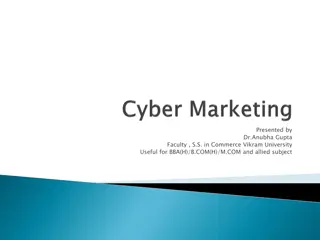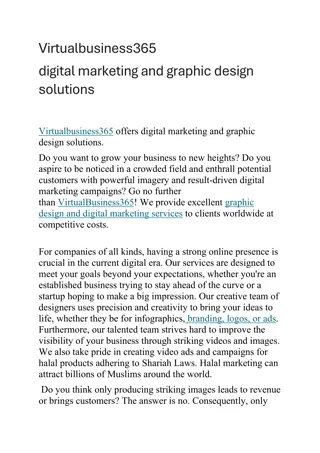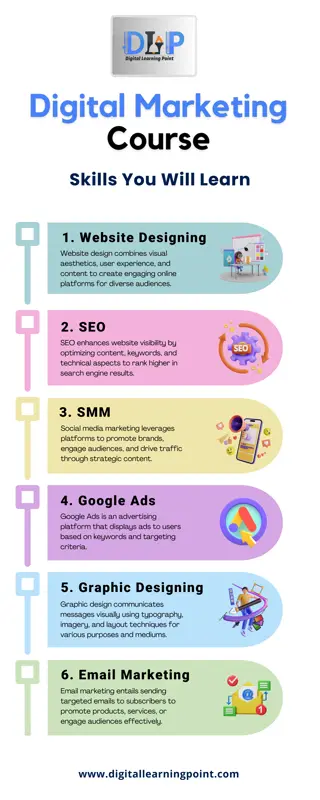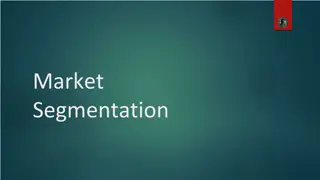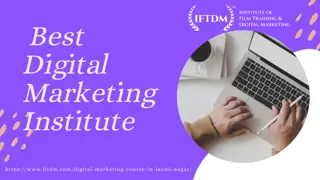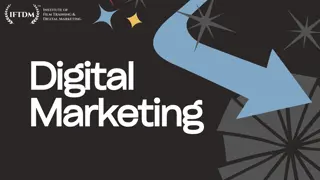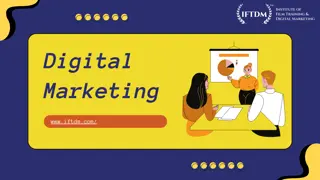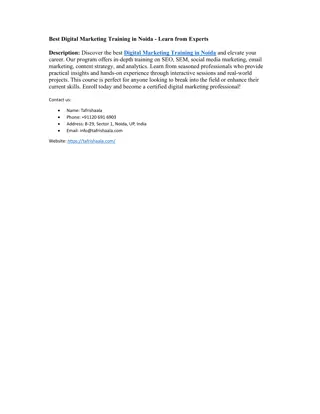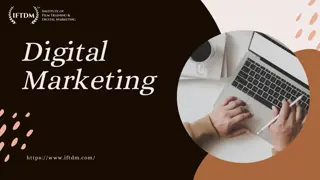
Understanding Marketing Concepts and Definitions
Explore the fundamental concepts of marketing, including market segmentation, supply chain management, and marketing ethics. Definitions by renowned experts like Philip Kotler and insights into different marketing approaches are discussed, shedding light on the evolving landscape of marketing practices.
Download Presentation

Please find below an Image/Link to download the presentation.
The content on the website is provided AS IS for your information and personal use only. It may not be sold, licensed, or shared on other websites without obtaining consent from the author. If you encounter any issues during the download, it is possible that the publisher has removed the file from their server.
You are allowed to download the files provided on this website for personal or commercial use, subject to the condition that they are used lawfully. All files are the property of their respective owners.
The content on the website is provided AS IS for your information and personal use only. It may not be sold, licensed, or shared on other websites without obtaining consent from the author.
E N D
Presentation Transcript
Introduction to Marketing By Prof. Pushpa Abbigeri Dept. of Commerce
Introduction Different Concepts of Marketing Functions of Marketing Marketing Research Supply Chain Management Marketing Channels Marketing Ethics Market Segmentation
Introduction Market The term market is originated from Latin word Marcatus which means a traffic or a place where business is conduiples of marketingcted . The term market is used to give the following meaning. Market is a public place where buyers and sellers make transactions directly or via intermediaries. A place where goods are offered for sale. A public gathering held for buying and selling merchandise.
Definitions Prof. Seligman: Market means coming together of offers and demand for economic goods irrespective of the physical presence of the contracting parties. J. F. Pyle: Market includes both place and region in which buyers and sellers are in free competition with one another Thus the term market refers to the getting together of buyers and sellers in person, by mail telephone, telegraph, cable or by any other means of communication. Market is not necessarily a place but it is an arrangement providing an opportunity to exchange goods.
Definitions of Marketing: Philip Kotler defines marketing as 'satisfying needs and wants through an exchange process J. F. Pyle: Marketing is that phase of business activity through which human want are satisfied by the exchange of goods or services P. Tailor: 'Marketing is not about providing products or services it is essentially about providing changing benefits to the changing needs and demands of the customer
Different Concepts of Marketing Production Concept of Marketing Till 1930 it was believed that if product is good and the price is reasonable, the consumer response will be favourable and there is no need for special marketing effort. This concept assumes that- Anything that can be produced can be sold. It is important to reduce cost of production A firm should produce only certain basic products
Product Concept According to this conceptthe consumer response is favourable for superior quality product. This concept encourages product innovation, quality assurance and research and development.
Selling Concept The failure of the production concept paved the way for change in the outlook and it was possible during 1940s. Sales orientation concept assumes that consumers do not voluntarily buy unless they are induced by effective sales efforts. This concept gives importance to the sales promotion techniques and aggressive selling.
Marketing Concept The marketing concept was introduced after 1950. This concept holds that the primary task of business firm is to study the needs and wants of target markets and delivering the desired satisfactions more effectively and efficiently than competitors. Under marketing concept, the emphasis is on selling and satisfaction and not merely on the selling a product. The objective of marketing is not the maximization of profitable sales volume, but profits through the satisfaction of customers.
Social Concept This concept is the result of the developments in social and economic development in 1970s. It was realized that techniques of marketing employed for marketing goods and services can be applied to social problems. Application of theories and techniques of modern marketing to social issues is known as social marketing. Social concept focuses not only on customer satisfaction but also for consumer welfare. Such a social welfare gives stress on pollution free environment and quality of human life.
Difference between Traditional & Modern Marketing 1. Traditional marketing refers to a mere physical process concerned with the exchange of goods Modern marketing is not just a physical process but it is concerned with the creation of goods 2. Traditional marketing is sales oriented Modern marketing is consumer oriented 3. Focusses on sellers needs Focusses on customer needs 4. Aim is to maximize profit through increased sales Aim is to maximize profit through customer satisfaction 5. Concentrates on sellers need Concentrates on consumers need 6. Succeeds only there is a sellers market (Scarcity of goods ) Succeeds not only there is a sellers market but also in buyers market
Features of Modern marketing Modern marketing is consumer oriented The primary aim of modern businesses is to satisfy the consumers by meeting their needs. It is the consumer who decides what should be produced and sold in the market. Modern marketing begins and ends with the consumers Today before production takes place, efforts are made to find out what the consumers really want and in what quantity they want. The goods are produced according to their needs and sold at a price desired by them. Modern marketing before production Product planning and development is undertaken before the actual production takes place. In modern businesses every firm has to undertake market research and collect market information to find out what is actually needed by the consumers. Modern marketing is the guiding element of business At present competition is more acute as many entrepreneurs produce similar commodities e. Marketing has also become a still competition. The ability of the marketer depends on the ability of finding a consumer and to satisfy him. Market potential guides the business today.
Marketing Functions Functions of exchange Buying Selling Functions of physical supply Transportation Storage & Warehousing Facilitating Functions Financing Risk Bearing Standardization & Grading Market Information
Marketing Research Marketing research is the application of scientific methods for solving marketing problems. It is the systematic gathering, recording, and analysis of qualitative and quantitative data about issues relating to marketing products and services. " .
Objectives of Marketing Research 1)To provide basis for proper planning- Marketing and sales forecast research provides sound basis for the formulation of all marketing plans, policies, programmes and procedures. 2) To reduce marketing costs - Marketing research provides ways and means to reduce marketing costs like selling, advertisement and distribution etc. 3) To find out new markets for the product Marketing research aims at exploring new markets for the product and maintaining the existing ones. 4) To determine proper price policy - Marketing research is considered helpful in the formulation of proper price policy with regard to the products.
Contd Objectives of Marketing Research 5) To study in detail likes and dislikes of the consumers - Marketing research tries to find out what the consumers, think and want. It keeps us in touch with the consumers, minds and to study their likes and dislikes. 6) To know the market competition - Marketing research also aims at knowing the quantum of competition prevalent in the market about the product in question. The company may need reliable information about competitor s moves and strategies which are of immense significance for further planning. 7) To study the external forces and their impact - Marketing research provides valuable information by studying the impact of external forces on the organisation. External forces may include conditions developing in foreign markets, govt, policies and regulations, consumer incomes and spending habits, new products entering in the market and their impact on the company s products.
Procedure of Marketing Research: : 1. Defining and analyzing the problem Research starts with a problem that management is facing. This problem needs to be understood, the cause diagnosed, and solutions developed. Research problems focus on providing the information needed to solve the problem. 2. Research design - The research design is a plan or framework for conducting the study and collecting data. It is defined as the specific methods and procedures used to acquire the information you need.A research study may need both primary and secondary data.
Contd.. Procedure of Marketing Research: 3. Data collection - There are many ways to collect data. Two important methods to consider are interviews and observation. Primary data is collected by researcher for the first time, while secondary data is already available for processing. Primary data can be assembled through a number of methods such as survey and observation or experimental method. Interviews require you to ask questions and receive responses. Common communication include interviews conducted face-to-face, by mail, by telephone, by email, or over the Internet. Another way to collect data is by observation. Observing a person s or company s past or present behavior can predict future purchasing decisions. Data collection techniques for past behavior can include analyzing company records and reviewing studies published by external sources. modes of research
.Contd. Procedure of Market Research 5. Analysis and interpretation In order for data to be useful, it must be analyzed. Analysis techniques vary and their effectiveness depends on the types of information collected. A meaningful analysis can be performed by using various statistical techniques. 6. Preparation of a research report- The report should provide all the information the decision maker needs to understand the project. Presenting the major conclusions and recommendations supported by necessary analysis, is the end product of the research process.
Supply chain management (SCM Supply chain management (SCM), the management of the flow of goods and services, involves the movement and storage of raw materials, work-in-process inventory, and of finished goods from point of origin to point of consumption. Supply-chain management has been defined planning, execution, control, and monitoring of supply chain activities with the objective of creating net value, building a competitive infrastructure, leveraging worldwide logistics, synchronizing supply with demand and measuring performance globally. The market logistics is the easiest way to deliver the goods to the customers. Integrated logistics system(ICS) include material management, material flow system and physical distribution. These functions are increasingly being outsourced to other firms that can perform the activities better or more cost effectively. In many cases the supply chain includes the collection of goods after consumer use for recycling. as the "design,
Benefits of SupplyChain Management Reduced Costs - Supply chain management involves identifying those processes that increase cost without increasing the value of the final product. These processes are wasteful and do not add value, and should be eliminated whenever possible. Increased Efficiency - - Resource wastage is a common source of increase production costs. Often this is due to improper planning. A company that employs supply chain management is able to achieve efficiency of its operations since only those value adding activities are encouraged. This ensures that the organization s processes flow smoothly and output keeps inline with the company's needs.
Contd..Benefits of Supply Chain Management Increased output - A company that employs supply chain management can foster close-knit relationships with its suppliers and customers, ensuring the timely fulfillment of orders. A company known for its timeliness and responsiveness will attract more customers, and will grow as a result of increased output and sales. Increased Profits - Businesses exist to make profits. One of the most efficient ways of increasing a company s profits is by ensuring that costs are kept as low as possible. The application of supply chain management by a small company leads to cost reductions due to elimination of wasteful processes. Since these are operating costs for the company, the savings on these costs reflect increased profits by the company.
Elements of SCM : Integration This could beconsidered the brains and heart of the supply chain. Overseeing supply chain integration means coordinating communications between the rest of the supply chain to produce effective and timely results. Often, this means exploring new software or other technological means to foster communications among departments. Those in charge of integration are responsible for making sure that things are happening on time and on the budget, without sacrificing quality. Operations - This link in the supply chain coordinates the specifics of day-to-day operations for the company. It plans the company s output to make sure everything is running well and that advantages are maximized. Operations will keep an eye on company inventory. They use business forecasting to predict which supplies will be needed when and by whom and also to find ways to predict the effectiveness of products, marketing approaches, as well as end-user results. Overall, the company s production is overseen by operations.
Contd Elements of SCM Purchasing - This department sources the materials, products, or other goods needed to generate the company s products. Purchasing creates relationships with suppliers and also identifies the qualities and quantities of necessary items. It s very important for those in purchasing to keep an eye on the budget for things to be cost- effective for the company, as well as adhering to high-quality standards. Distribution - The logistics of communications among retailers, clients, or wholesalers is the responsibility of the distribution part in the supply chain of command. These groups must keep on eye on shipments, and to know not only what is needed in-house to produce products but also that the products get to the end- customer on time and in good shape.
Marketing Channels A channel refers to a way of making a product available to distribute to the end consumers. A marketing channel helps by getting the right products to the right consumer in time for purchase. Marketing channels are the ways that goods and services are made available for use to the consumers. A marketing channel is the people, organizations, and activities necessary to transfer the ownership of goods from the point of production to the point of consumption. The channel of distribution may grouped as - Direct Channel : Producer/ Manufacturer selling to Consumer directly Indirect Channel: Producer/ Manufacturer selling through middlemen like brokers, wholesalers, retailers etc.
Producer Customer The producer sells the goods or provides the service directly to the consumer without a middleman such as a wholesaler, a retailer, an agent, or a retailer. For example, a farmer may sell some produce directly to customer, a bakery may sell cakes and pies directly to customers. Producer Retailer Consumer This channel works best for manufacturers that produce shopping goods like, clothes, shoes, furniture toys etc. Since consumers need more time with these items before they decide to purchase them, it is in the best interest of the manufacturer to sell them to another user before it gets into the hand of the consumer The fact suggests that manufactories produce large goods and products but limited in its assortment and merchandise. Producer Wholesaler Retailer Customer Consumer s can buy directly from the wholesaler. The wholesaler breaks down bulk packages for resale to the consumer. The wholesaler reduces some of the cost to the consumer such as service cost or sales force cost, which makes the purchase price cheaper for the consumer. The work of wholesaler makes it less burdensome for the transportation of production.
Producer Agent/Broker Wholesaler Customer This distribution channel involves more than one intermediary before the product gets into the hands of the consumer. Agents come into play when the producers need to get their product into the market as quickly as possible. This happens mostly when the item is perishable and has to get to the market fresh before it starts to rot. Broker is usually dependent on the commission of a sold product or production in terms of goods. Producer Agent/Broker Retailer Customer This wholesaler and goods move to consumers through agents. Broker/Agents are useful when goods need to move quickly into the market soon after the order is placed. distribution channel involves elimination of
Marketing Ethics Ethics is the study dealing with what is the proper course of action for human or living being. It is the study of right and wrong in human behaviors.Marketing ethics deals with the moral principles behind the operation and regulation of marketing. .
Ethical Issues in Marketing Improper market research and grouping can lead to stereotyping that shapes undesirable beliefs and attitudes and consequently affect marketing behavior. For example, assuming that all women like pink and therefore basing an entire advertising campaign on that belief could be a costly mistake. Irresponsible Market Research - Unethical Advertising and Promotion - Making false claims about what the product does and its importance is an unethical way to gain profit. It is also considered unethical to shame a substitute or rivals product or services. Other ethical issues include, mistreatment of women, advertising to children, misleading advertising and other issues, which lead to ethical decline of society. Mistreatment of women is evident immensely in advertisements. Often women are matched up with household products such as cleaning supplies and are shown as doing domestic work, which represents stereotyping of women.
Contd. Ethical Issues in Marketing Unethical pricing practices Businesses constantly lower its prices in an attempt to demoralize its competition. Price wars can create psychologically devastating situations, which has an extraordinary impact on an individual, a company and industry profits. The intention of a price war is to drive competitors out of the market or to create an entry barrier into the market. Although it is beneficial for consumers, as they will get the product or service at a low price, however they are often deprived for quality. Also in the long term, it will force other competitors out of business and lower profits threaten business survival. Delivery channel practices- Direct marketing is the most controversial of advertising channels, particularly when approaches are unsolicited. TV commercials and direct mail are common examples. Dealing with competitors- Many companies advertise cheap prices to attract customers and once they draw in the customers, switch them over to a more costly product, because the advertised good was not available, insufficient or not of any value to the customer. emotionally devastating and








